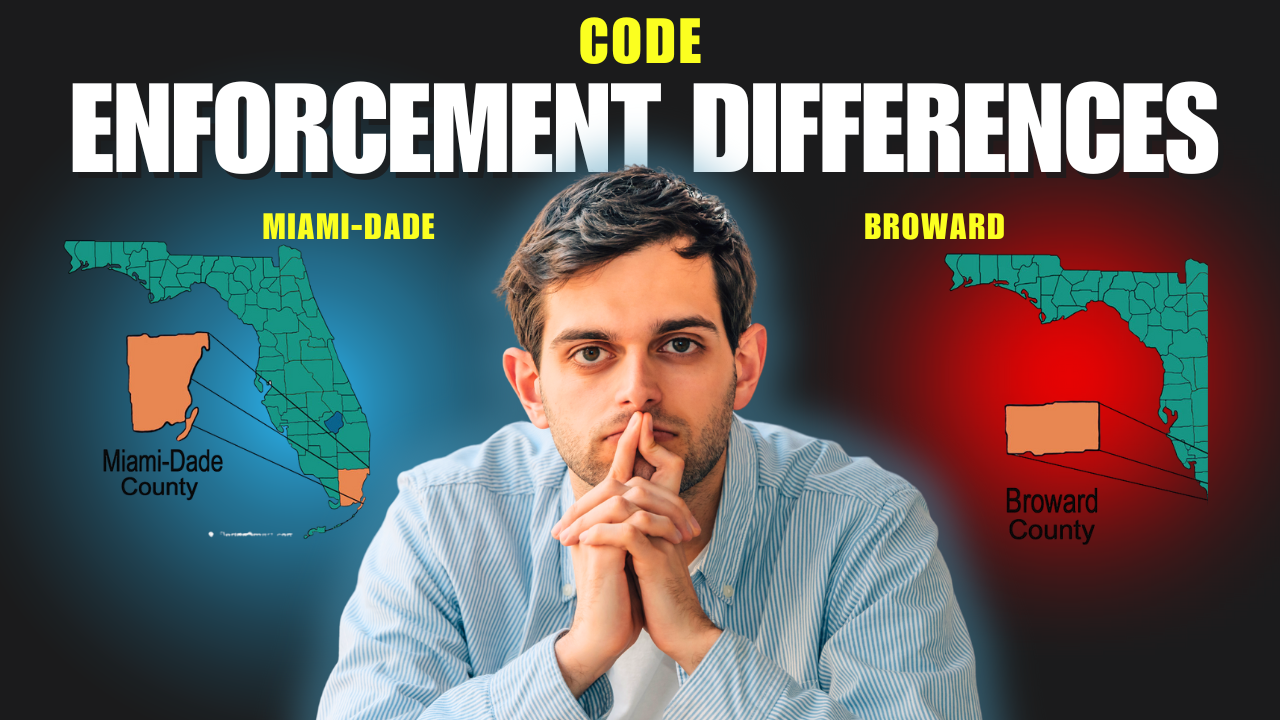If you’re a homeowner, business owner, or real estate professional in South Florida, you know that navigating local regulations is a fact of life. While Miami-Dade and Broward counties share a border and a subtropical climate, their approaches to code enforcement can have significant differences. Understanding these nuances is key to staying compliant and avoiding costly penalties.
Here’s a look at some of the key distinctions between Miami-Dade and Broward code enforcement.
1. The Local Layer of Regulation
Both counties are governed by the state of Florida’s building codes and statutes. However, each county, and in some cases, each individual municipality within the county, has its own unique set of ordinances. This means that while the core building code may be the same, a specific rule about fences, hedges, or commercial vehicle parking might differ dramatically just by crossing the county line.
- Miami-Dade County: Miami-Dade County has a Department of Regulatory and Economic Resources that handles code enforcement for unincorporated areas and certain regulatory jurisdictions. It’s a large, centralized system that covers a broad range of issues from building code violations like work without a permit and unsafe structures to neighborhood nuisances like graffiti and residential property maintenance.
- Broward County: Broward County also has a Code Compliance division, but many of the day-to-day code enforcement duties are handled by individual municipalities. While there is a county-wide code of ordinances, it’s essential to check the specific rules of the city or town where your property is located. For instance, the city of Lauderhill will have its own code enforcement rules that may differ from those in Pembroke Pines.
2. The Role of Anonymous Complaints
One of the most significant and recent changes to Florida law has been the handling of anonymous complaints, which affects both counties.
- Florida Statute: As of July 1, 2021, Florida law prohibits code inspectors from investigating potential code violations based on an anonymous complaint unless the inspector determines, based only on the information provided, that the violation poses an imminent threat to public health, safety, or welfare.
- The Impact: This change has shifted the burden of proof and requires citizens to provide their name and address for a non-imminent threat complaint to be investigated. Both Miami-Dade and Broward have adapted their procedures to comply with this new state law.
3. Fines and Enforcement Procedures
The penalties and processes for dealing with a violation can also vary. While the ultimate goal is compliance, the path to getting there might be different.
- Miami-Dade County: When a civil violation notice is issued in Miami-Dade, you typically have two options: pay the civil penalty and correct the violation, or request an administrative hearing to appeal the inspector’s decision. If a case is not resolved, it may be heard by a hearing officer or a Code Enforcement Board. Continuing civil penalties (daily fines) can be imposed until the violation is corrected, and these fines can result in a lien being placed on the property.
- Broward County: In Broward County, the process is similar but may be handled at a more local level by a Special Magistrate or Code Enforcement Board. Fines for violations can range from $50 to $250 for first offenses and $100 to $500 for repeat violations. Like Miami-Dade, daily running fines can accumulate, and the county may even abate a health or safety violation themselves (e.g., mowing an overgrown yard) and charge the property owner for the cost.
4. Specialized Regulations
Certain types of regulations have different requirements in each county. A prime example is building recertification and drainage standards, which are critical for anyone in the construction and real estate industries.
- Building Recertification: While a new statewide Milestone Inspection law applies to condos and co-ops, both Miami-Dade and Broward have had their own 40-year building recertification ordinances for decades (or 25 years for structures within three miles of the coastline). These local ordinances often have more stringent requirements, such as mandating recertification of both structural and electrical systems, whereas the state law focuses primarily on structural integrity.
- Drainage and Water Quality: Miami-Dade County is known for its strict focus on water quality protection and aquifer recharge, which is reflected in its drainage requirements. Broward County, on the other hand, emphasizes flood risk management with more rigorous standards for detention and critical infrastructure. For developers, this means the same project might require different stormwater management plans depending on which side of the county line it falls.
The Bottom Line
While the overall goal of code enforcement is consistent—to ensure public health, safety, and welfare—the specific rules, procedures, and enforcement styles can differ significantly between Miami-Dade and Broward. The key takeaway is to always do your research based on your specific location.
At ViolationClinic.com, we specialize in helping property owners navigate the recertification process smoothly. Whether you need assistance with inspections, violations, or compliance issues, our team is here to help. Don’t wait until it’s too late, take action today to protect your investment and ensure the safety of your building.
For more information or assistance, contact us at ViolationClinic.com!
